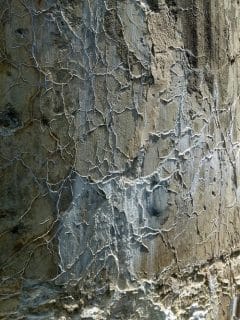Diagnosis of waterproofing issues always proves to be a challenge. This is especially because most areas prone to waterproofing failures are usually difficult to access. To mitigate against this, most Concrete waterproofing systems are designed to last as long as the structure. However, poor design and workmanship leads to waterproofing-related failures.
Signs of waterproofing issues;
Bubbling or peeling paint; mold vegetative growth; dampness, stains, odors; efflorescence, or white powdery deposits; cracks, rust, wood rot
Generally, Concrete waterproofing on a structure, is an impermeable substance that blocks water ingress. Waterproofing is a necessity since building clad materials cannot do this and only act as weather barriers.

Positive-side waterproofing Vs. Negative-side waterproofing
Positive-side waterproofing
Positive-side waterproofing provides a water-tight barrier on the side of applied hydrostatic pressure. For a foundation, this would be the surface in contact with the soil.
Types of positive side waterproofing systems:
- fluid-applied membranes— mostly used in roofing. They cure to form a seamless membrane
- sheet systems—These include single-ply thermoplastics and rubberized asphalts
- hybrid systems—These are fluid-applied membranes with embedded fabric reinforcing to create a stronger waterproof barrier
- bentonite clay— is a natural mineral which swells in the presence of moisture to create a barrier.
Positive-side waterproofing systems are considered more effective than the negative-side applications since they create a structural barrier against ground water or even damage resulting from freeze-thaw cycle damage.
Their only disadvantage comes during inspection or repair since excavation and reconstruction would be necessary once the backfill in place
Negative-side waterproofing
Negative-side waterproofing protects the surface opposite the side of applied hydrostatic pressure. It does this by redirecting water after it enters the substrate.
These materials include:
- cementitious systems—a combination of chemical waterproofing additives or acrylics with cement and sand to achieve an impermeable surface
- acrylic, latex, or crystalline additives—products that penetrate into the surface to provide water protection.
Since the negative side is more accessible, it is easier to identify leaks than with positive-side systems. Negative-side coatings or injections also can be applied as a retrofit measure.
The major disadvantage with negative-side waterproofing is that moisture still penetrates the wall structure. This provides good conditions for mold to grow and can even make the concrete deteriorate. The repair of unattended concrete deterioration ends up being a very costly affair and should be remedied from the onset.
Dampproofing vs. waterproofing
Even though the terms waterproofing and dampproofing are used interchangeably, they aren’t similar. Dampproofing often entails the application of bitumen-based or cementitious treatments to the positive side of foundation walls. This is meant to block moisture from reaching the below-grade walls through capillary action.
On the other hand, waterproofing offers a more comprehensive moisture protection. A waterproofing membrane is flexible, has crack bridging properties, and therefore can withstand some levels of settlement and shrinkage.
For this reason, damproofing should never be an alternative for waterproofing. The lower up-front cost of dampproofing solutions due to their lower quality and sparse application are always outweighed by their shorter durability and lack of effectiveness in some instances. The application of waterproofing membranes requires greater care and can be reinforced for stability using integral fabrics.
Conclusion
Even when using quality systems, vigilance is a prerequisite as it helps address any issues before they get out of hand. Appropriate design and application, coupled with due diligence can help prevent the expensive affair of waterproofing rehabilitation.
By engaging the services of an experienced waterproofing contractor, even the most demanding waterproofing issues can be successfully addressed. But since prevention is better than cure, the best approach is to ensure basements, tunnels, roofs, below-grade levels, water features, and other critical areas are correctly waterproofed from the outset.
For a free site-visit, quotation or technical advice on any waterproofing related issues, do not hesitate to contact In Doors East Africa LTD.

